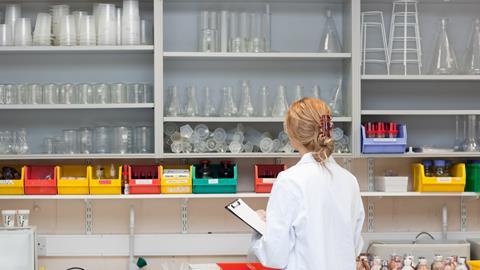Schools are struggling to cope with fewer science technicians and more examined practical work. What has led to the shortfall, what needs to be done and how can teachers weather the crisis?
Andy Chandler-Grevatt explains worrying decline in school science technicians revealed by a recent survey. What has led to the shortfall, what needs to be done and how can teachers weather the crisis?
School science technicians are often unnoticed by students, or seen as a person in a white coat hidden in the ‘prep room’, a mysterious place students are not allowed to enter. Yet they are an integral part of any school science department. Technicians prepare practical lessons for teachers, ensure secure storage of chemicals and equipment, and oversee laboratory safety. To a science teacher, their technician is often much more than that.
It is hard to imagine a science department without technicians, but that is the reality for an increasing number of schools.
Anecdotal concerns from teachers and technicians triggered a closer look at the problem. In September 2017 the Association for Science Education (ASE) released highlights from the ASE Technician Survey [pdf].
Dwindling technician support
The results revealed that the current technician supply in schools is often far below what is expected for adequate safety in school science lessons. The survey was based on almost 400 schools, including academies, state schools and independent schools.
Over the past year, the number of technicians fell in about 50% of state schools, 40% of academies and 10% of independent schools surveyed. The percentage of schools that gained technicians is much smaller (5%, 10% and 15% respectively). The trend is clear: state schools and academies are losing their technicians.
Even when a school expands, it is unlikely to gain more technician support. Of the schools that did increase in size, more than two-thirds retained the same number of technicians, and some even had a decrease (25% of academies and state schools, and 10% of independent schools).
Undervalued and overworked
The reasons for these startling results are mainly financial, but compounded by other issues. Financial shortfalls are becoming critical for many state schools. Technicians are easy targets for financial cuts by senior management, who often undervalue their expertise.
On the other hand, schools that need more technicians are finding it challenging to recruit and retain them. Low pay, little opportunity for promotion and reduced hours are all factors. An academy technician in the survey states: ‘We are currently trying to recruit more technicians but there are few suitable applicants. The level of pay available is a significant factor in reducing the pool of applicants.’
Not only are the numbers of technicians falling, but their employment hours are being cut, with many now on term-time only contracts. One school technician feels desperate: ‘the number of technician hours is being cut all the time but the amount of work is going up all the time … There should be at least one 52-week technician at each school … it really needs to change.’
Technician workloads are exacerbated by the increasing demand for practical work from the curriculum and exam boards. ‘Our technicians now do not have enough time to prepare an ever increasing practical requirement … [they] are at breaking point’, laments another department head. Technicians are also increasingly asked to take on additional tasks outside their area of expertise by those who misunderstand their roles.
Unattainable benchmarks for good practical science
This decline in technician support has dire consequences, not only for education, but also for the safety of teachers and pupils. A science head of department in the survey says the shortfall leads to less hands-on practical work for pupils: ‘We can’t guarantee practicals will be set up especially if the technician is part-time and not there the day before to get it ready. As a department we do a lot of practical work, but now with reduced technical support, we can see that this is leading to increased demonstrations.’
The reduced time that technicians are in school, especially on term-time only contracts, affects laboratory maintenance, stock checks and safety checks. A science teacher points out: ‘This will mean that the quality of technician service will reduce due to overwork and lack of qualified technicians. This could (or will) impact on health and safety, less time to prepare lessons and very little time to repair equipment.’
Against this backdrop, the Gatsby Charitable Foundation recently published its Good Practical Science report. It sets out ten benchmarks for practical science, which emphasise the importance of technicians:
Science departments should have enough technical or technician support to enable teachers to carry out frequent and effective practical science.
Benchmark 6 – Good Practical Science
The ASE Technician Supply Survey revealed that many schools, particularly state-funded schools, will be unable to meet this benchmark. Only a third of state schools have the specialist technicians they need, compared with two-thirds of academies and four-fifths of independent schools. The greatest shortage is in physics specialist technicians, followed by chemistry, then biology.
Solutions for technicians and teachers?
The survey revealed one example where a head of department and their technician challenged the cuts on health and safety grounds: ‘We have been able to push management to meet the minimum service factor* of 0.65 but not to meet our school service factor which is 0.85. We have found the ASE and CLEAPPS resources very helpful in doing this.’

Clearly, there need to be some policy, organisational and budgetary changes, at a government and school level, to influence the squeeze on school resources. Organisations such as the ASE are addressing this. However, there are things teachers and technicians can do to weather the crisis.
Katherine Forsey, in collaboration with a team of technicians and teachers, has come up with suggested strategies to ensure a successful technician–teacher relationship [pdf, £]. The recommendations include: practice professional, open, honest communication; have mutual respect of each other and roles; help each other out; build trust by communicating professionally; avoid forming cliques, teacher and technician ‘them and us’ situations; and stay positive – get through it together.
A strong theme from the technicians involved is that they feel undervalued and misunderstood. As teachers, we can at least make them feel appreciated by taking time to say ‘thank you’.
Andy Chandler-Grevatt is a member of the ASE 11–19 Committee and an ITE Curriculum Tutor at the University of Sussex
*Multiplying the number of weekly science teaching hours by the service factor gives the minimum recommended weekly technician hours. A minimum service factor of 0.65 was previously suggested by the ASE as the minimum necessary to provide adequate technical support in a science department.
We asked technicians on the preproom.org discussion forum for their suggestions for how to foster a successful teacher–technician relationship. Take a look at what they had to say.
Here’s what you had to say about this article.
References
A Chandler-Grevatt, Education in Science, 2017, 269, 10
K Forsey, Education in Science, 2017, 269, 8
J Holman, Good Practical Science, London: Gatsby Charitable Foundation, 2017
A Chandler-Grevatt, Education in Science, 2017, 269, 10
K Forsey, Education in Science, 2017, 269, 8
J Holman, Good Practical Science. London: Gatsby Charitable Foundation, 2017 (bit.ly/2gfcphX)






![I stock 000015347604 300m[1]](https://d1ymz67w5raq8g.cloudfront.net/Pictures/100x67/6/8/8/113688_istock_000015347604_300m1.jpg)



No comments yet